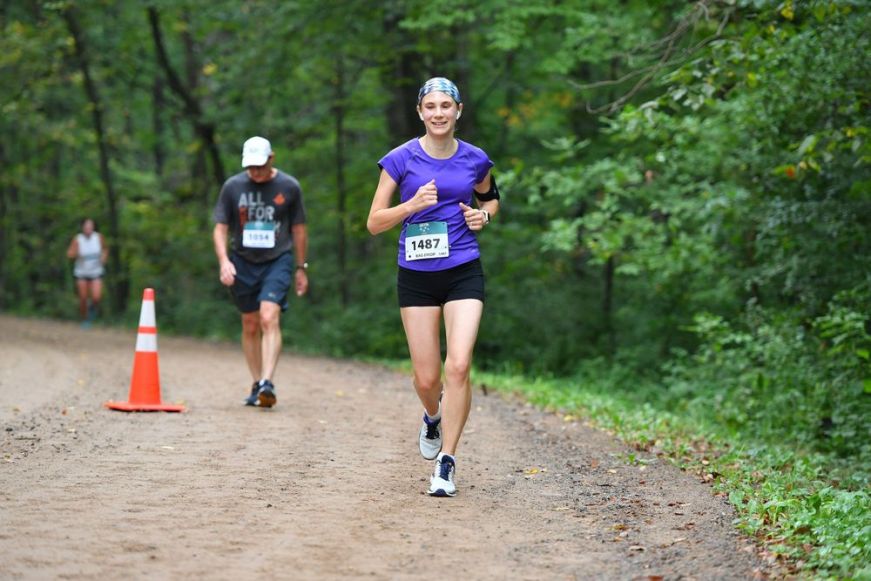For over a decade, running has been an important part of my life. I'm not a natural-born runner (I struggled to finish the mile in gym class and usually came in last), so building up my endurance and speed has given me an immense sense of accomplishment and pride. Running helps me manage stress, process my emotions, and boost my mood. It's given me an appreciation for the park reserve near my house, as well as places I've traveled.
Starting in the spring of 2021, my mile pace slowed from 8:30 to 9:00 minute miles to 10:30 minute miles, likely due to my chronic insomnia worsened by the stress of the pandemic. Still, for the most part I was able to keep up my usual running schedule, with four runs per week: 5 miles on Tuesday and Thursday, 7 miles on Saturday, and 3 miles on Sunday.
But in the fall of 2021, my running routine went off the rails. The ongoing stress of the pandemic had shredded my self-image as a resilient, capable person, and when I went for runs, I was consumed with self-doubt. I started having panic attacks mid-run. It became a struggle to finish even 3 miles in one go—I'd run for a mile or so, start hyperventilating and having chest pains, and then slow down to a walk, while a voice inside my head harangued me for being a failure. Eventually, I would calm down enough to start running again, and then the process would repeat.
For years, running had been a source of joy and helped me cope. For it to become a source of emotional pain and stress was devastating.

Something had to change. My approach to most things—my writing career, my mental health, my relationships, this blog—is to throw a lot of different things at the wall and see what sticks. Most problems don't have one big solution; instead, there are a lot of things that each improve the situation a little bit. I turned to Google for some ideas, but all I could find were articles about regaining your running motivation or recovering from a physical injury. Those weren't exactly what I was dealing with—I desperately wanted to run, and physically I was fine—but it at least gave me a starting point.
Over the past year, there are several things I did to regain my confidence as a runner. I realize that this is a highly unscientific study with a sample size of one, but I wanted to share what worked for me as a jumping off point for others who might be struggling with a similar loss of confidence, running or otherwise.

1. Run on a treadmill
Typically, I prefer running outside, but when I was struggling with panic attacks, running on treadmill gave me the sense of control that I needed to actually be able to finish my runs. It was reassuring to know that I could just hit the stop button and end my run without being stranded miles from home. In hindsight, I think running at a consistent pace also may have had a calming effect.
2. Add a soundtrack
A big part of why I couldn't finish my runs was because I started worrying that I wouldn't finish my runs. To disrupt my cycle of negative self-talk, I made a Spotify running playlist and listened to it every time I went for a run (previously, I would usually listen to podcasts while running on the treadmill and not listen to anything while running outside).
You can check out my playlist here—it's an eclectic mix of songs that I've loved since high school, like "Drunken Lullabies" by Flogging Molly, some oldies, stuff from my favorite artists like the Gaslight Anthem, Brian Fallon, the Interrupters, and Fitz and the Tantrums, and songs that have gotten me through tough times ("Get Better" by Frank Turner especially).

3. Consider the timing
When I quit my full-time paralegal job in 2018, I started running in the late afternoon/early evening, usually around 4:00 p.m. or 5:00 p.m. Although that makes the most sense schedule-wise, when I'm sleep deprived my energy craters in the early afternoon and doesn't bounce back until after dinner. I switched to start running after dinner when possible, and my higher energy level gave me a boost of confidence.
4. Recalibrate expectations
I had gotten stuck in a brutal cycle: I wasn't performing at the level I wanted to, so I would get upset and berate myself for not living up to my expectations, which would make my performance on my next run even worse. I wouldn't be able to regain my confidence without breaking that cycle, so I used December 2021 as a reset.
Instead of trying to run 5 or 7 miles, I shortened all of my runs to 3 miles. Rather than trying to run at my pre-pandemic pace, I set my treadmill to 10:30 minute miles. Recalibrating my expectations so that I could complete my runs gave me a sense of accomplishment, and that was essential to rebuilding my confidence.

5. Maintain a routine
Even though I was running shorter distances than I typically would, it was mentally beneficial to maintain my usual Tuesday, Thursday, Saturday, and Sunday schedule—it gave me an additional sense of accomplishment to stick to my routine. When I started increasing my mileage in January, I stuck to my previous routine: I kept my Sunday runs at 3 miles, and added 0.5 mile to my other runs each week until I got back to my usual mileage of 5 miles on Tuesday and Thursday and 7 miles on Saturday. Then, I focused on speeding up my pace based on a schedule I mapped out each month.
6. Work towards a goal
I made two New Year's Resolutions for 2022: take a trip abroad (COVID anxiety had made it difficult for me to travel, which could be a whole other blog post) and run a 10-mile race. I had run 10 miles in the past—St. Paul's Monster Dash in 2017 and 2019, plus a few 10-mile runs on my own while I was training for those races. Building up to 10 miles after a month of only running 3 miles at a time felt ambitious but manageable, especially since I was planning to run my race in late October.
There were still plenty of challenges to work through. After running successfully on the treadmill for several months and building back to running 20 miles per week, I was anxious about running outside, and I didn't transition to outdoor runs until May (usually I start running outside as soon as the snow melts in March or April). Although my pace did slow down at first, I was able to complete all of my runs—achieving my series of goals around sticking with a routine and building up my mileage had given me the confidence I needed to run outdoors again without melting down into self-doubt. As my pandemic anxiety has ebbed and flowed, there have been periods when my insomnia made running a slog. On the logistical side, I had planned to run the Monster Dash again, but since it no longer includes a 10-mile race, I had to scramble to find another option and ended up with a race that was 5 weeks earlier than the race date I had been training for.

But I did it: on September 17, 2022, I finished the 10-mile Stillwater Log Run in 1:30:34, a respectable average mile pace of 9:04. Since then, my pace has continued to speed up, and I'm planning to run two 10-mile races in 2023.
Regaining my confidence as a runner took almost a year of effort. It was worth it—I'm thankful to have reclaimed running as something that gives me joy, and I'm thankful to have reclaimed the resilient, capable part of myself.
